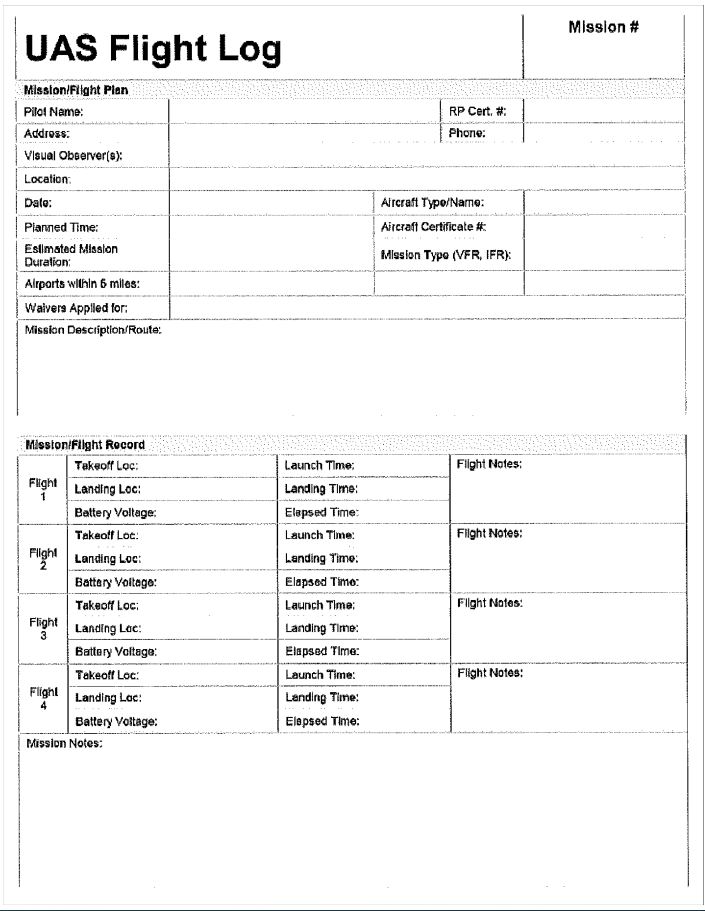(A) Procedure for flight approval. Regardless of flight purpose, anyone intending to fly a UAS for the city must notify the City UAS Coordinator.
(B) AS registration requirement.
(1) UAS that weigh more than 0.55 pounds must be registered with the FAA before an application is submitted. Proof of registration must be submitted with the application.
(2) UAS registration number and owner contact information must be listed on the UAV.
(3) Non-US citizens who are not eligible to register a UAS in the United States must follow the FAA guidelines.
(C) Employee UAS operation. Employees operating UAS on behalf of the city must adhere to the following:
(1) Obtain approval from the city's UAS department;
(2) Hold a valid FAA remote pilot certification or be under the supervision of a person who does hold a remote pilot certificate;
(3) Ensure that their UAS is registered and insured; and
(4) Complete any required city UAS training.
(D) Payload authorization. The person requesting authorization to operate a UAS must identify the payload function, size, and weight. Access points or any devices that might interfere with city networks are prohibited.
(E) Prohibited UAS use. UAS operation is prohibited if any person(s) acting as a UAS pilot:
(1) Consumed alcohol in the past 12 hours;
(2) Have used any drugs that affect the person's faculties in any way; or
(3) Operated without a permit.
(F) Standard operating rules.
(1) The remote pilot in command must conduct a pre-flight inspection. The remote pilot should record the pre-flight inspection via hard copy document or appropriate web-based application.
(2) The remote pilot may not go forward with the operation if he or she believes that there are any physical or mental conditions, drug- or alcohol-induced or otherwise, that would interfere with the safe operation of the UAS.
(3) The remote pilot must maintain visual line-of-sight at all times.
(4) Where possible, a visual observer should assist in operations.
(5) No operations over people unless those people are directly participating in the operation.
(6) Operations within daylight hours only. City UASs may operate during twilight hours (30 minutes before official sunrise to 30 minutes after official sunset) if the UAS has anti-collision lighting.
(7) UASs must always yield the right-of-way to other aircraft.
(8) Maximum ground speed of 100 mph (87 knots).
(9) Maximum altitude of 400 feet above ground level.
(10) A UAS may go above 400 feet if it remains within 400 feet of a structure.
(11) Operations must stay within Class G airspace, well away from airports. However, should the pilot in command determine that to perform city duties operations may move into Class B, C, D or within the lateral boundaries of the surface area of Class E airspace, the remote pilot must request and receive permission from the appropriate Air Traffic Controller. Operations should also, where practicable, stay at least one mile away from heliports, including hospitals with heliports.
(12) UASs may only fly when visibility is at least at three miles.
(13) No operations from a moving aircraft.
(14) No operations from a moving vehicle unless the operation is over a sparsely populated area.
(15) No careless or reckless operations (e.g., no stunt flying).
(16) No carriage of hazardous materials.
(17) In the event of operations that lead to serious injury, loss of consciousness, or property damage of at least $500, it is the remote pilot's responsibility to make an official report to the FAA. This can be done in coordination with designated city supervisors or personnel.
(G) Operating limitations; waivers.
(1) All remote pilots must make sure UAV operation falls within the standard FAA Part 107 operating rules.
(2) If it becomes clear that compliance with a certain or multiple of FAA Part 107's limitations is not practical to get the full benefit of the city's UAS usage, the remote pilot or responsible individual should bring such to the attention of the UAS coordinator or other assigned supervisor.
(3) The city will then make an application to the FAA for a waiver for the specific FAA Part 107 limitation.
(4) Waivers are available for:
(a) Operation from a moving vehicle or aircraft (FAA § 107.25);
(b) Daylight operation (FAA § 107.29);
(c) Visual line of sight aircraft operation (FAA § 107.31);
(d) Visual observer (FAA § 107.33);
(e) Operation of multiple small unmanned aircraft systems (FAA § 107.35);
(f) Yielding the right of way (FAA § 107.37(a));
(g) Operation over people (FAA § 107.39);
(h) Operation in certain airspace (FAA § 107.41); and
(i) Operating limitations for small unmanned aircraft (FAA § 107.51).
(H) Pre-flight/post-flight. Pre-flight checklists and mission logs must be conducted for each UAS mission by the pilot in control or by a third party for the City of Linton. If more than one drone is flown during the same mission, each drone and its flight details must be recorded on the mission log report. Below are examples of a pre-flight checklist and a UAS flight mission log.
(Ord. 2022-05, passed 8-8-2022) Penalty, see § 100.99

